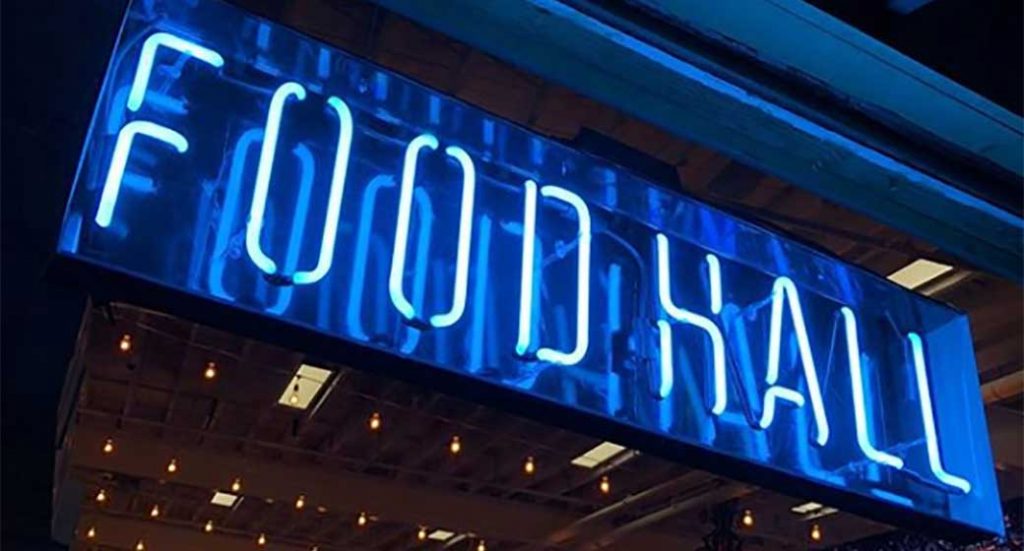You may have heard the term “Food Hall” thrown around recently. But unless you have one in your town or have visited one yourself, you may be a bit confused as to what exactly constitutes a food hall.
The term “food hall” has its roots in the UK where it is used to describe a section of a department store where food is sold. This definition of a food hall is fairly close to its American, mall-dwelling cousin, the food court.
However, in contrast to the typical mall food court that is filled with fast food franchises and samples of bourbon chicken, the modern food hall concept revolves more around artisanal or niche restaurant concepts. This mix of restaurants is often paired with other businesses such as butcher shops, bakeries and related retail offerings (think: spices, cookware, etc.).
“There are a number of different types of food hall concepts,” says Chris Corso, owner of Corso Ventures, the company that created the Short North Food Hall in Columbus, Ohio. “For example, our food hall is more bar-centric. We offer a destination that encourages customers to stay and watch the game or hang out.”
It could take more than a million dollars to do a stand alone restaurant from scratch. With a food hall like ours, a restaurateur … can get up an running for a fraction of that cost. – Chris Corso, Short North Food Hall
For customers, the appeal of a food hall is pretty straightforward. How often do you have a group of people who can’t agree on where to go to eat? With a food hall, everyone can select from a variety of food offerings and still have a communal meal. Or you can sample cuisines from several different vendors to create your own custom meal that would be difficult if not impossible for a single restaurant to offer.
The social and experience aspects of food hall dining are especially attractive to the millennials who find the concept attractive for their lifestyles.
“It feels like younger people are more into food these days, especially with things like Instagram and Snapchat. Social media exposes them to new food trends more quickly. And a food hall allows them to experience those food trends for themselves,” says Corso.
Lower Start-Up Costs Help Drive Innovation
For the businesses that occupy a food hall, the benefits may be even more powerful. Since the dining area is a shared resource, no one business has to shoulder those costs alone. By ordering at the counter, the businesses are able to reduce their personnel costs because there are no waitstaff. At the Short North Food Hall, the venue also provides the kitchen spaces, the prep area and the point-of-sales systems so start-up costs are even further reduced.

Some food halls simply rent space to vendors and then it is up to the individual businesses to cover many of those start up costs. But even so, the typical cost of creating a presence in a food hall environment is much less than a traditional restaurant launch.
“You have to consider that it could take more than a million dollars to do a stand alone restaurant from scratch. With a food hall like ours, a restaurateur with a good product can get up an running for a fraction of that cost…maybe $10k or so,” says Corso.
And perhaps even more significantly, the shared customer traffic of a food hall often allows niche cuisine concepts to thrive in a way that would be difficult if not impossible in a stand-alone restaurant.
Many restaurateurs have been using food halls to test new concepts or as a way to introduce existing concepts to a wider audience.
Food halls are popping up all over the US. Cities have been reaping the benefits of having a destination dining venue that can serve as an anchor for other attractions such as theaters, sports venues, shopping districts and more.
“Restaurants and food attract people. So it’s a natural fit for a city that is looking for a way to attract people to an area,” says Corso.
The Future of Food Halls
So what’s next for food halls? Just as the food hall concept sort of evolved from the basic mall food court, Corso says that he has seen an extension of the food hall concept in Europe that may just be the next step in the concept’s evolution.
“They have giant warehouse buildings that house 5 or 6 full restaurants. So instead of just sort of an offshoot of a foodtruck or niche concept, you have several different full restaurants to bounce between all in one large space,” says Corso.
We can’t wait to see how the food hall idea creatively evolves as they pop up around the country. You can find extensive lists of existing food halls in your area or you can check out Thrillist’s list of the 17 Best Food Halls in America.
Do yourself a favor and gather up a few friends and explore all that food halls have to offer!




Food Halls in New York City - A Dose of You and Me